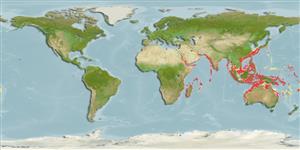Environment: milieu / climate zone / depth range / distribution range
экология
морской демерсальный; пределы глубины 54 - 300 m (Ref. 127946). Tropical
Indo-West Pacific: confirmed from Indonesia and Australia (Ref. 127946). Museum specimens known from the Red Sea, Somalia coast and Zanzibar. Also known from the Bay of Bengal, Arafura Sea and the Philippines (Ref. 3542). Reports from Japan are based on a different species.
Size / Вес / Возраст
Maturity: Lm ? range ? - ? cm
Max length : 15.4 cm SL самец/пол неопределен; (Ref. 127946)
Краткое описание
определительные ключи | морфология | морфометрия
колючие лучи спинного плавника (общее число) : 9; членистые (мягкие) лучи спинного плавника (общее число) : 15 - 16; членистые (мягкие) лучи анального плавника: 14 - 16; позвонки: 32 - 33. This species is distinguished by the following characters: the lateral profile of body with slight convex curve from posterior part of first dorsal fin base to the moderately narrow caudal peduncle; with a narrow but distinct postorbital notch above and behind each eye and faint furrow across nape at rear of interorbital space; the rostral process with broad to deep medial notch and nearly straight to slightly curved anterior edge on each rostral lobe to triangular spine of moderate size at apical corner; pored lateral line scales 58-61; scales above lateral line 3 and below about 14-17; D1 IX, second distinctly longer than first, barely longer than third, and subsequent spines progressively shorter; D2 15-16 rays; A 15 (rarely 14 or 16) rays; pectoral fins reaching about fourth or fifth anal fin ray, the first free pectoral fin ray reaching to between anus and base of third anal fin ray, not or just reaching tip of pelvic fin. Colouration: a broad red band just distal to middle of caudal fin with broad ventrally tapering pink margin and transverse red band basally; inner surface of pectoral fin dark greenish brown with a large black patch covering ventral third to half of fin from base to distal margin except for fine red margin dorsally and distally and broad red margin ventrally, prominent white spots are scattered over all but red areas on fin (Ref. 127946).
A tropical to warm temperate species (Ref. 9771). Occurs over soft bottom of the continental shelf. Benthic (Ref. 75154). Excellent food fish (Ref. 3542).
Life cycle and mating behavior
половая зрелость | размножение | нерест | икра | Fecundity | личинки
Gomon, M.F. and T. Kawai, 2018. A review of Indonesia’s Indian Ocean species of Lepidotrigla gurnards (Teleostei: Scorpaeniformes: Triglidae) with descriptions of three new species from southern coastal waters. Raffles Bull. Zool. 66:624-651. (Ref. 127946)
Статус Красного Списка МСОП (Ref. 130435: Version 2024-1)
Угроза для людей
Harmless
Использование человеком
рыболовство: не имеет хозяйственного значения
дополнительная информация
инструменты
Специальные отчеты
Скачать в формате XML
ресурсы в Интернет
Estimates based on models
Preferred temperature (Ref.
123201): 17.8 - 26.9, mean 22.4 °C (based on 499 cells).
Phylogenetic diversity index (Ref.
82804): PD
50 = 0.5000 [Uniqueness, from 0.5 = low to 2.0 = high].
Bayesian length-weight: a=0.00676 (0.00325 - 0.01404), b=3.05 (2.87 - 3.23), in cm total length, based on LWR estimates for this (Sub)family-body shape (Ref.
93245).
Trophic level (Ref.
69278): 3.5 ±0.3 se; based on size and trophs of closest relatives
устойчивость к внешним воздействиям (Ref.
120179): высокий, минимальное время удвоения популяции до 15 месяцев (Preliminary K or Fecundity.).
Fishing Vulnerability (Ref.
59153): Low vulnerability (10 of 100).
